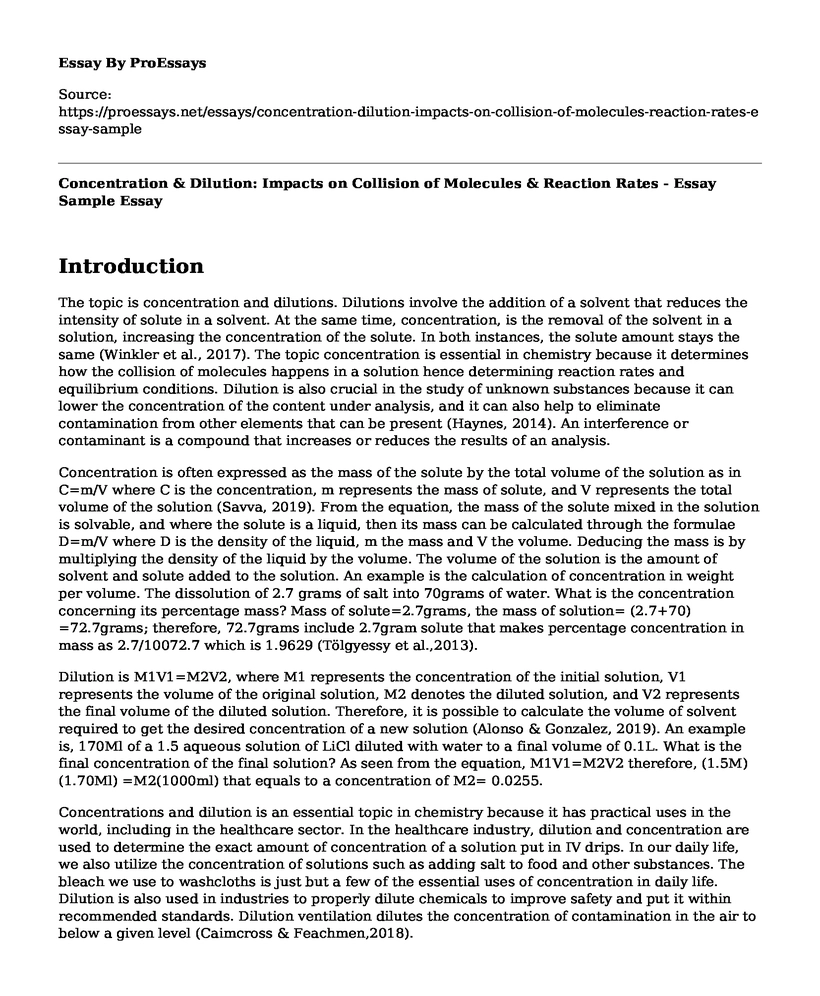Introduction
The topic is concentration and dilutions. Dilutions involve the addition of a solvent that reduces the intensity of solute in a solvent. At the same time, concentration, is the removal of the solvent in a solution, increasing the concentration of the solute. In both instances, the solute amount stays the same (Winkler et al., 2017). The topic concentration is essential in chemistry because it determines how the collision of molecules happens in a solution hence determining reaction rates and equilibrium conditions. Dilution is also crucial in the study of unknown substances because it can lower the concentration of the content under analysis, and it can also help to eliminate contamination from other elements that can be present (Haynes, 2014). An interference or contaminant is a compound that increases or reduces the results of an analysis.
Concentration is often expressed as the mass of the solute by the total volume of the solution as in C=m/V where C is the concentration, m represents the mass of solute, and V represents the total volume of the solution (Savva, 2019). From the equation, the mass of the solute mixed in the solution is solvable, and where the solute is a liquid, then its mass can be calculated through the formulae D=m/V where D is the density of the liquid, m the mass and V the volume. Deducing the mass is by multiplying the density of the liquid by the volume. The volume of the solution is the amount of solvent and solute added to the solution. An example is the calculation of concentration in weight per volume. The dissolution of 2.7 grams of salt into 70grams of water. What is the concentration concerning its percentage mass? Mass of solute=2.7grams, the mass of solution= (2.7+70) =72.7grams; therefore, 72.7grams include 2.7gram solute that makes percentage concentration in mass as 2.7/10072.7 which is 1.9629 (Tölgyessy et al.,2013).
Dilution is M1V1=M2V2, where M1 represents the concentration of the initial solution, V1 represents the volume of the original solution, M2 denotes the diluted solution, and V2 represents the final volume of the diluted solution. Therefore, it is possible to calculate the volume of solvent required to get the desired concentration of a new solution (Alonso & Gonzalez, 2019). An example is, 170Ml of a 1.5 aqueous solution of LiCl diluted with water to a final volume of 0.1L. What is the final concentration of the final solution? As seen from the equation, M1V1=M2V2 therefore, (1.5M) (1.70Ml) =M2(1000ml) that equals to a concentration of M2= 0.0255.
Concentrations and dilution is an essential topic in chemistry because it has practical uses in the world, including in the healthcare sector. In the healthcare industry, dilution and concentration are used to determine the exact amount of concentration of a solution put in IV drips. In our daily life, we also utilize the concentration of solutions such as adding salt to food and other substances. The bleach we use to washcloths is just but a few of the essential uses of concentration in daily life. Dilution is also used in industries to properly dilute chemicals to improve safety and put it within recommended standards. Dilution ventilation dilutes the concentration of contamination in the air to below a given level (Caimcross & Feachmen,2018).
Conclusion
The concept of dilution and concentrations is fundamental in daily life, and knowledge in the topics can be instrumental in estimating the amount of solute to put in a solution such as tea. The uses stretch from domestic to health to the industrial application, where the knowledge can help to manage environmental pollution by industries. Therefore, it is an essential topic in chemistry because it affects daily life in different ways.
Bibliography
Alonso, J., & Gonzalez, P. (2019). Isotope dilution mass spectrometry. Royal Society of Chemistry.
Cairncross, S., & Feachem, R. Environmental Health Engineering in the Tropics: Water ... https://www.routledge.com/Environmental-Health-Engineering-in-the-Tropics-Water-Sanitation-and/Cairncross-Feachem/p/book/9781844071913.
Haynes, W. M. (2014). CRC handbook of chemistry and physics. CRC press.
Savva, M. (2019). Dilution and Concentration of Pharmaceutical Solutions and Other Physical Mixtures. In Pharmaceutical Calculations (pp. 93-112). Springer, Cham.
Tölgyessy, J., Braun, T., & Kyrš, M. (2013). Isotope Dilution Analysis: International Series of Monographs in Analytical Chemistry (Vol. 49). Elsevier.
Winkler, M. K., Boets, P., Hahne, B., Goethals, P., & Volcke, E. I. (2017). Effect of the dilution rate on the microbial competition: r-strategist can win over k-strategist at low substrate concentration: ploS one, 12(3).
Cite this page
Concentration & Dilution: Impacts on Collision of Molecules & Reaction Rates - Essay Sample. (2023, Aug 28). Retrieved from https://proessays.net/essays/concentration-dilution-impacts-on-collision-of-molecules-reaction-rates-essay-sample
If you are the original author of this essay and no longer wish to have it published on the ProEssays website, please click below to request its removal:
- A Bulky Glycocalyx Fosters Metastasis Formation by Promoting G1 Cell Cycle Progression
- Surfactants, Magnetic Field, Cleaning up Oil on Birds' Feathers
- Paper Example on General Physics: Vectors and Projectiles, Newton's Law and Motion Etc.
- Essay Sample on Separation of Benzoic Acid and Naphthalene Using One Base for Extraction
- Essay Sample on Organic Compounds: Benefits for Optoelectronic Devices
- Essay Example on the Psychic Staring Effect: Fact or Fiction?
- Essay Example on Colorado River Dwindles: Drought, Irrigation Take Toll on Iconic Stream







